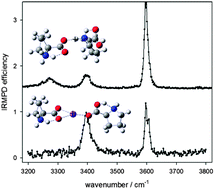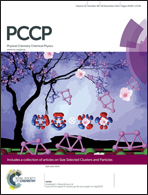The protonated and sodiated dimers of proline studied by IRMPD spectroscopy in the N–H and O–H stretching region and computational methods†
Abstract
IRMPD spectroscopy and computational chemistry techniques have been used to determine that the proton- and sodium-bound dimers of proline exist as a mixture of a number of different structures. Simulated annealing computations were found to be helpful in determining the unique structures of the protonated and sodiated dimers, augmenting chemical intuition. The experimental and computational results are consistent with the proton-bound dimer of N-protonated proline bound to zwitterionic proline. There was no spectroscopic evidence in the 3200–3800 cm−1 region for a canonical structure which is predicted to have a weak N–H stretch at about 3440 cm−1. A well resolved band at 1733 cm−1 from a previous spectroscopic study (DOI: 10.1021/ja068715a) was reassigned from a high energy canonical isomer to the C![[double bond, length as m-dash]](https://www.rsc.org/images/entities/char_e001.gif) O stretch of a lower energy zwitterionic structure. This band is a free carboxylate C
O stretch of a lower energy zwitterionic structure. This band is a free carboxylate C![[double bond, length as m-dash]](https://www.rsc.org/images/entities/char_e001.gif) O stretch where protonated proline is hydrogen bonded to the other carboxylate oxygen which is also involved in an intramolecular hydrogen bond. Fifteen structures of the sodium bound proline dimer were computed to be within 10 kJ mol−1 of Gibbs energy and eight structures were within 5 kJ mol−1. None of these structures can be ruled out based on the experimental IRMPD spectrum. They all have an N–H stretching band predicted in a position that agrees with the experimental spectrum. However, only structures where one of the proline monomers is in the canonical form and having a free O–H bond can produce the band at ∼3600 cm−1.
O stretch where protonated proline is hydrogen bonded to the other carboxylate oxygen which is also involved in an intramolecular hydrogen bond. Fifteen structures of the sodium bound proline dimer were computed to be within 10 kJ mol−1 of Gibbs energy and eight structures were within 5 kJ mol−1. None of these structures can be ruled out based on the experimental IRMPD spectrum. They all have an N–H stretching band predicted in a position that agrees with the experimental spectrum. However, only structures where one of the proline monomers is in the canonical form and having a free O–H bond can produce the band at ∼3600 cm−1.


 Please wait while we load your content...
Please wait while we load your content...